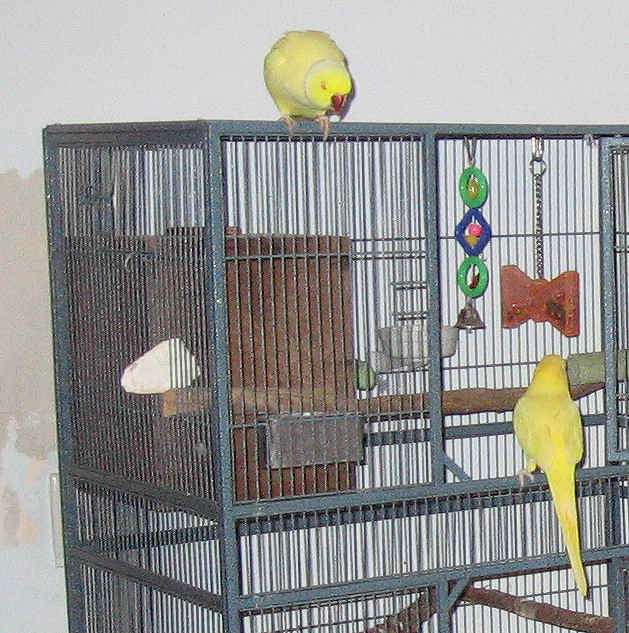|
|
Post by leopard74 on Feb 5, 2011 20:55:42 GMT 10
Hello friends,
I have green split blue hen and gray cock bird, both nearly 2 years old came from different places 1 month ago and I put both of them in a same large cage. now they seems to be get together each other. hen was completely wild but cock was kept in a dining room in a small cage for 2 years.
I put a large bird breeding box inside the cage too. I want to know that when they will start breeding in Adelaide area. the cage is under the shed in backyard. and what colors they will produce?
thanks for help in advance.
|
|
|
|
Post by avinet on Feb 5, 2011 22:17:14 GMT 10
Hello friends, I have green split blue hen and gray cock bird, both nearly 2 years old came from different places 1 month ago and I put both of them in a same large cage. now they seems to be get together each other. hen was completely wild but cock was kept in a dining room in a small cage for 2 years. I put a large bird breeding box inside the cage too. I want to know that when they will start breeding in Adelaide area. the cage is under the shed in backyard. and what colors they will produce? thanks for help in advance. Breeding season is the spring so in Adelaide I would expect September through to November. It is very rare to get Ringnecks to breed outside of their breeding season. A grey ringneck is actually a combination of two clours - blue and grey-green (sometimes called olive). When these two mutations are present at the same time the bird has a grey colour. So a grey cock and a green split blue hen should give you the following. 50% grey and 50% grey-green split blue and they can be of either sex. You will get no blues since grey-green is a dominant mutation and so always combines with blue to form grey. Even if your hen was blue instead of split blue still no blue babies - all the babies would be greys. cheers, Mike |
|
|
|
Post by leopard74 on Feb 6, 2011 9:42:59 GMT 10
Thanks Mike,
U seems to be a very knowledgeable person in birds field. Thanks for this very useful information. I have few more questions please.
My gray parrot has black semi ring near his beak and other half (back side of neck) is white. But in my knowledge, that should be red ring. I m from India and the interesting fact about ring-necks that we (Indians) know that these birds comes in only one color, and that is green. I never heard or seen any other color mutation in India. I was very surprised to see all other colors. So due to black and white ring, I am still confused that is my bird really from ringneck family or some other species? And is half/ half blk and white ring means that it is still under development? May that will turn fully black when fully develop. Can I send u a photo to verify that?
And someone told me that in a small cage, they will not breed. Is that true? My cage is 1.5mtr x 1.5mtr x 1mtr with a 25cm x 25cm x 50cm breeding box inside. Do I have to buy a larger cage?
Please recommend me a good ringneck book also.
Sorry to ask lots of questions but I am very curious and pet loving person.
Thanks for helping me.
|
|
|
|
Post by avinet on Feb 6, 2011 10:50:44 GMT 10
Your male sounds completely normal for a grey ringneck. Their ring is black and white - the white occurring where a green ringneck would have pink. Have a look at jsbirds.com.au/indian.htm to compare. The wild ringneck you are familiar with is indeed green but in the wild there is the occasional mutation to other colours, most commonly yellow or blue. However these abnormally coloured birds in the wild either get hunted out or if they reach breeding age will likely pair with a normal green bird and the colour is lost. In aviculture if one of these colours appear then it can be established by careful breeding. There are several breeders of ringneck mutations in India - so they are there but you have to be in the aviculture groups to find them. Your cage is OK - just! they will breed in that but a bigger aviary is better - best would be around 3 x 1.5 metres and 2 metres high. However i breed a pet pair of mine every year in their cage in the house, and have done so for 12 or more years. The nest box is just about big enough - ideally a bit deeper but I wouldn't worry - I've had pairs use a cockatiel box with no problems. Far more important than aviary or box is the diet of ringnecks - a good diet, especially from June onwards is very important. Given a good diet and a stress-free environment ringnecks are good breeders. The best book by far for ringnecks is Phil Robson's book - The Indian Ringneck Breeders Handbook. I have been selling some on Ebay recently but no longer have any left - see cgi.ebay.com.au/ws/eBayISAPI.dll?ViewItem&item=280621722310&ssPageName=STRK:MESOX:IT for some information about it. It will be available on the net - do a Google to find sellers. The photo shows my two pet ringnecks with their cage and box. The male is 18 years old and the hen is 17 years old. cheers, Mike  |
|
|
|
Post by leopard74 on Feb 6, 2011 22:43:58 GMT 10
Thanks Mike, your birds are very beautifull. and i found that book on eBay also. Thanks for your help. Cheers  PS: and these are my lovely birds Attachments:
|
|